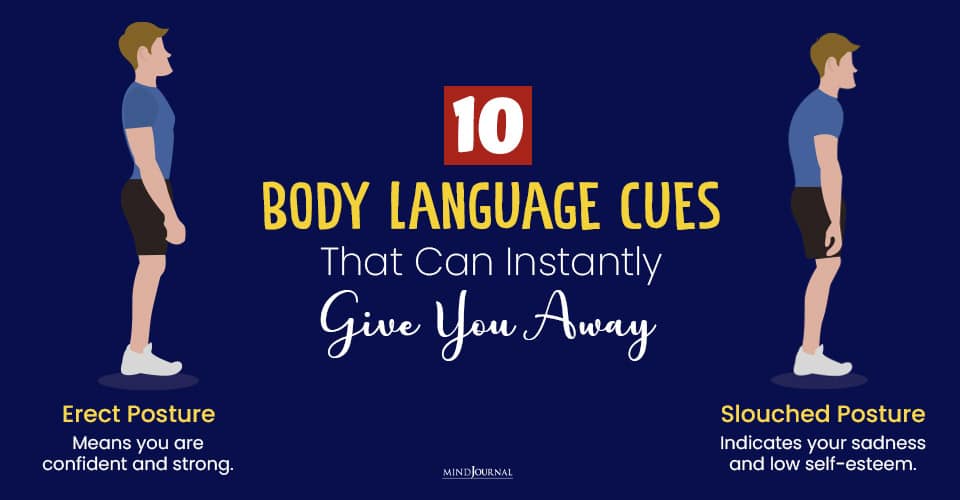Do you know that no matter how hard you try, there are a few body language cues that can immediately give you and your thoughts and intentions away?
Can other people “read your body language like a book” (the title of a best-selling book from the 1960s)? Not really. Body language is not a true “language.” In other words, there is no one single meaning to a particular nonverbal cue. There are, however, some cues that an astute person can use to infer what you are thinking or feeling.
What are some of these body language cues that give you away?
10 Body Language Cues That Can Instantly Give You Away
1. Fake smiling.

Nonverbal communication expert psychologist Paul Ekman distinguishes between true smiles (what he calls “Duchenne smiles”) and fake smiles.
Duchenne smiles indicate true happiness. Fake smiles don’t. We use fake smiles when we are trying to look amused, but really aren’t, or when we are uncomfortable around someone, but want to appear like we’re having a good time.
What is the key between “real” and “fake” smiles? Both have the upward turned corners of the lips, but in Duchenne smiles, the eyes become narrowed and the outer corners crinkle into what we call “crow’s feet.”
Related: Your Body Language Doesn’t Lie. Here Is How You Can Strip Down Naked Everyone’s Personality
2. Self-soothing.

This is an easy one. When we are anxious, stressed, or uncomfortable, we tend to engage in self-soothing nonverbal cues – hand rubbing, hand-to-body contact, stroking a leg, or neck.
It is our attempt to calm our anxieties through self-touching.
3. Posture.

The way we carry ourselves is a subtle clue, but one that can give away our true feelings. When we are proud and confident, an erect posture might give us away. Sad and dejected, we may be slouching with heads down.
4. Gaze behavior.

Are the “eyes the window to the soul”? Maybe not, but they can tell others something about our interest in them (Do we look at them when they are talking, or look away? Are we sizing them up with our eyes? Sexual attraction?)
5. Shortfall signals.

These are nonverbal cues that suggest that we are under-reacting. The fake smile is one type of shortfall signal – that we are not really happy or amused. Another shortfall is when we show limited, or fake, outrage at something someone has said.
Typically, shortfall signals suggest that we are not as engaged in what’s going on as we might/should be.
Related: Body Language: From Common Signs to Spotting Lies
6. Pupil dilation.

A very subtle cue that only the most astute observers can detect is pupil dilation. Our pupils dilate when we are interested in something or someone (that magnificent car that we desire).
7. Displacement activities.

When we are very tense or anxious we engage in nonverbal behaviors that help us cope with the anxiety–scratching your head, rubbing your hands, fiddling with jewelry, and other self-soothing behaviors.
Such self-soothing behaviors are sometimes used by customs agents or law enforcement officials as signs of nervousness that suggest that someone might be guilty of smuggling or criminal activity.
8. Facial laterality.

Normally, our facial cues are lateral – when we smile, both corners of the mouth go up; when surprised, both eyes open wide. When facial cues are non-lateral, it can suggest that something is wrong – we are displeased, confused, or perturbed. The raising of one eyebrow is a good example, suggesting we don’t trust what another is saying.
9. Nonverbal leakage.

Paul Ekman coined this term to suggest that when we are lying we take great pains to cover any obvious nonverbal cues that might give us away. So, when we are lying we make sure to look the other person in the eye, to look confident, and to avoid obvious cues of nervousness.
However, our discomfort at lying may “leak out” in those parts of our body that we can’t easily control. We may shift our posture, engage in self-soothing behaviors, have a shaky tone of voice, or become flushed. A savvy detector of deception looks for these inconsistent and less-controlled nonverbal cues to determine if you are lying or telling the truth.
Related: 15 Common Body Language Blunders That Successful People Avoid
10. Tie signs.

These are nonverbal cues that demonstrate to others that we are being “possessive” with another individual. Say you are interested in and engaged in conversation with some stranger at a party and another person approaches. You may move closer to your “target,” perhaps even touching them as a tie sign displaying “ownership.”
When we want to demonstrate our connection to lovers or others we are close to, we may hold hands, put an arm over the shoulder, or move close together to demonstrate that we are “tied” to one another.
If you want to know more about body language cues, then check this video out below:
Written By Ronald E. Riggio Originally Appeared In Psychology Today












Leave a Reply